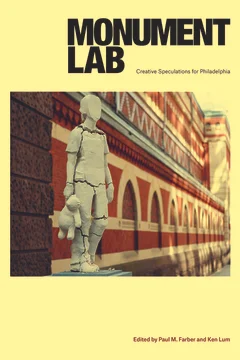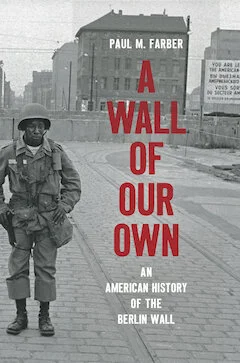Current Book Projects
Monument Lab: Creative Speculations for Philadelphia
Co-Edited with Ken Lum
(Temple University Press, 2019)
What is an appropriate monument for the current city of Philadelphia? That was the question posed by the curators, artists, scholars, and students who comprise the Philadelphia-based public art and history studio Monument Lab. And in 2017, along with Mural Arts Philadelphia, they produced and organized a groundbreaking, city-wide exhibition of temporary, site-specific works that engaged directly with the community. The installations, by a cohort of diverse artists considering issues of identity, appeared in iconic public squares and neighborhood parks with research and learning labs and prototype monuments.
Monument Lab is a fabulous compendium of the exhibition and a critical reflection of the proceedings, including contributions from interlocutors and collaborators. The exhibition and this handbook were designed to generate new ways of thinking about monuments and public art as well as to find new, critical perspectives to reflect on the monuments we have inherited and to imagine those we have yet to build. Monument Lab energizes a civic dialogue about place and history as forces for a deeper questioning of what it means to be Philadelphian in a time of renewal and continuing struggle.
Contributors: Alexander Alberro, Alliyah Allen, Laurie Allen, Andrew Friedman, Justin Geller, Kristen Giannantonio, Jane Golden, Aviva Kapust, Fariah Khan, Homay King, Stephanie Mach, Trapeta B. Mayson, Nathaniel Popkin, Ursula Rucker, Jodi Throckmorton, Salamishah Tillet, Jennifer Harford Vargas, Naomi Waltham-Smith, Bethany Wiggin, Mariam I. Williams, Leslie Willis-Lowry, and the editors.
Artists: Tania Bruguera, Mel Chin, Kara Crombie, Tyree Guyton, Hans Haacke, David Hartt, Sharon Hayes, King Britt and Joshua Mays, Klip Collective, Duane Linklater, Emeka Ogboh, Karyn Olivier, Michelle Angela Ortiz, Kaitlin Pomerantz, RAIR, Alexander Rosenberg, Jamel Shabazz, Hank Willis Thomas, Shira Walinsky and Southeast by Southeast, and Marisa Williamson.
Book Review:
Hyperallergic, “What Constitutes an “Appropriate Monument”? Philadelphians Have a Few Ideas”
“‘Speculative monuments’ are no longer relegated to the purview of arts organizations, but a vital part of protest and public discourse. In 2020, Monument Lab: Creative Speculations for Philadelphia is not merely a living handbook as the publisher suggests, but an uncanny prophecy.” – Olivia Jia
Praise for Monument Lab
“Monument Lab is a stunning achievement—at once a profound meditation on the crisis of the public monument today and an inspirational guide for the future of democracy. In the voices of artists, scholars, curators, and citizens of all ages, colors, and life experiences, this book overflows with ideas about how to remake the monumental spaces we’ve inherited into living places of creativity, community, truth, and hope—places where all of us can declare, as the artist Karyn Olivier says, ‘This is me.’”—Kirk Savage, Dietrich Professor of History of Art and Architecture, University of Pittsburgh, and author of Standing Soldiers, Kneeling Slaves: Race, War, and Monument in Nineteenth-Century America
“ Public art has a long and distinguished history in Philadelphia. The Monument Lab project was designed not only to bring that history to the present but also to interrogate the very notion of what constitutes art in the public realm. Monument Lab is a testimony to the success of the endeavor, a record of the works and conversations related to the project, and a brilliant contribution to the wide conversation about the urgent topics related to the production and display of art outside the walls of a museum.”—Carlos Basualdo, the Keith L. and Katherine Sachs Senior Curator of Contemporary Art, Philadelphia Museum of Art
“ The Monument Lab project has taken the current controversies of public art and the future place of monuments and creatively engaged the public in serious and often playful ways. Using as its inspiring springboard the city of Philadelphia, with its prominent history and diversity, each monument described soars with meaning and conviction. This book reflects the many accomplishments of Monument Lab, which leads the nation in envisioning cities where public art is embraced by all.”—Elizabeth Goldstein, President, The Municipal Art Society of New York
“ Paul Farber and Ken Lum’s provocative report on the Monument Lab project asks important questions about public art and provides inspiring answers. What kinds of monuments do we need today? Start by engaging an entire city in thinking about whom and what we commemorate. What kind of art is appropriate? Ask the public to consider this as you commission twenty of today’s most thoughtful artists to create prototype monuments. The results are stunning: art that enlarges our understanding, inspires public participation, and both occupies space and operates through time.”—David B. Brownlee, Professor of the History of Art, University of Pennsylvania
A Wall of Our Own: An American History of the Berlin Wall
(University of North Carolina Press, 2020)
The Berlin Wall is arguably the most prominent symbol of the Cold War era. Its construction in 1961 and its dismantling in 1989 are broadly understood as pivotal moments in the history of the last century. In A Wall of Our Own, Paul M. Farber traces the Berlin Wall as a site of pilgrimage for American artists, writers, and activists. During the Cold War and in the shadow of the Wall, figures such as Leonard Freed, Angela Davis, Shinkichi Tajiri, and Audre Lorde weighed the possibilities and limits of American democracy. All were sparked by their first encounters with the Wall, incorporated their reflections in books and artworks directed toward the geopolitics of division in the United States, and considered divided Germany as a site of intersection between art and activism over the respective courses of their careers. Departing from the well-known stories of Americans seeking post–World War II Paris for their own self-imposed exile or traveling the open road of the domestic interstate highway system, Farber reveals the divided city of Berlin as another destination for Americans seeking a critical distance. By analyzing the experiences and cultural creations of "American Berliner" artists and activists, Farber offers a new way to view not only the Wall itself but also how the Cold War still structures our thinking about freedom, repression, and artistic resistance on a global scale.
Praise for A Wall of Our Own
"This is a work of history the way it should be written: thorough, brilliant analysis coupled with an extraordinary account of extraordinary people and their works in an extraordinary period of time. Highly recommended for everyone with an interest in history, especially the Cold War, and its artistic legacies."—Axel Klausmeier, Director, Berlin Wall Foundation
Intelligently conceived, rigorously researched, and highly insightful, A Wall of Our Own makes a unique and exciting contribution to cultural studies of the United States in the world, U.S. cultural history more generally, and the history of race and gender in the United States."—Melani McAlister, Professor of American Studies and International Affairs, George Washington University
Opinion/Editorial
• “Toppling racist statues makes space for radical change” in Al Jazeera (June 2020)
• “We finally removed a racist statue in Philly. What comes next for our public art?” in Philadelphia Inquirer (June 2020)
• “The coronavirus meteor has hit Philly’s arts community” in Philadelphia Inquirer (March 2020)
• “The Frank Rizzo statue’s future is bungled yet again” in Philadelphia Inquirer (December 2019)
• “How the Berlin Wall became a monument to American racial division” in Al Jazeera (November 2019)
• "Public Art in an Age of Urban Renewal" in PlanPhilly (March 2016)
• "What Cities Can Learn From Refugees Resettled at a Former Cold War Airport" in Next City (November 2015)
• "Die-Ins Demand We Bear Witness" in the Guardian (December 2014)
Public Art & History Books
Co-Editor
• Report to the City, Paul M. Farber, Ken Lum, and Laurie Allen (Monument Lab, 2018)
Newspaper: Report to the City
Editor/Historical Advisor
• Stephanie Syjuco: American Rubble (Micromonuments) – Stephanie Syjuco, Paul M. Farber, Susanne Slavick, Joshua Clover, Salamishah Tillet, and Camilo Vergara (Haverford College Hurford Humanities Center, 2016)
Essay: Reading Rubble
• The Wall in Our Heads: American Artists and the Berlin Wall – Paul M. Farber, Hope Harrison, and Jonathan Borofsky (Haverford College Cantor Fitzgerland Gallery, 2015)
Essay: Crossing Over
• Monument Lab: Creative Speculations for Philadelphia – Paul M. Farber, Ken Lum, and A. Will Brown (Penn Institute for Urban Research, 2015)
Newspaper: The Time is Now: Proposing Monuments for Philadelphia
• Made in Germany (New Critical Edition with Re-Made: Reading Leonard Freed) – Leonard Freed, Florian Ebner, and Paul M. Farber (Steidl Verlag, 2013)
Essay: "Open Door: Leonard Freed in Germany"
• This Is the Day: The March on Washington – Leonard Freed, Julian Bond, Michael Eric Dyson, and Paul M. Farber (Getty Publications, 2013)
Afterword: "In Leonard Freed's Footsteps"
• Kodachrome Memory: American Pictures 1972-1990 – Nathan Benn, Richard Buckley, and Paul M. Farber (powerHouse Books, 2013)
Essay: "The Unintentional Archive"
• Criticism, Special Issue: The Wire (Co-Edited with Robert LeVertis Bell) – Frederic Jameson, Paul Allen Anderson, Mark Anthony Neal, Adrienne Brown, James Braxton Peterson, Chris Love, Hua Hsu, and Leigh Claire La Berge (Criticism, 2011)
Editors' Preface
Essay: "The Last Rites of D'Angelo Barksdale: The Life and Afterlife of Photography in The Wire"
Selected Essays
• "Reflecting Forward: Jamel Shabazz and Historical Time" in Jamel Shabazz, Pieces of a Man: Photographs 1980-2015 (ArtVoices, 2016)
• “The Future of Monumentality: Monument Lab as Public History and Social Practice" in Art & the Public Sphere (Special Issue: Ethics and Social Practice) (2016)
• “Requiems, Reports, Resurrections: Archives and the Alchemy of Historical Inquiry” (Co-Written with Tayana Hardin and Grace Sanders Johnson) in Reconstruction (Special Issue: Archives on Fire) (2016)
“Queering the U.S. and the World: A Roundtable” (Co-Written with Mark Bradley, Laura Belmonte, Julio Capo, Shanon Fitzpatrick, Melani McAlister, David L. Minto, Michael Sherry, Naoko Shibusawa, and Penny Von Eschen) in Diplomatic History, 2016
• "On Exile: Tajiri's America" in Shinkichi Tajiri: Universal Paradoxes (Leiden University Press, 2015)
• "'I Cross Her Borders at Midnight': Audre Lorde's Berlin Revisions" in Audre Lorde's Transnational Legacies (University of Massachusetts Press, 2015)
• "I Have a Meme: Photography, Memory, and Digital Commemorations" in In Media Res: Race, Identity & Pop Culture in the 21st Century (Bucknell University Press, 2014)
• "Exhibit Review, National Museum of Crime & Punishment" in Museums & Social Issues (Special Issue: Rethinking Incarceration, 2012)

